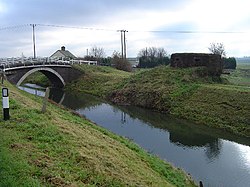Whittlesey: Difference between revisions
Created page with '{{Infobox town |name=Whittlesey |county=Cambridgeshire |picture=Turningtree Bridge, Whittlesey - geograph.org.uk - 84956.jpg |picture caption=Turningtree Bridge, Whittlesey |os g…' |
mNo edit summary |
||
| Line 13: | Line 13: | ||
|dialling code=01733 | |dialling code=01733 | ||
}} | }} | ||
'''Whittlesey''' is an ancient fenland market town in [[Cambridgeshire]]. It is some six miles east of [[Peterborough]], [[Northamptonshire]] and lies close to the county boundary with [[Huntingdonshire]]. | '''Whittlesey''' is an ancient fenland market town in [[Cambridgeshire]]. It is some six miles east of [[Peterborough]], [[Northamptonshire]] and lies close to the county boundary with [[Huntingdonshire]]. | ||
Revision as of 09:55, 11 October 2010
| Whittlesey | |
| Cambridgeshire | |
|---|---|
 Turningtree Bridge, Whittlesey | |
| Location | |
| Grid reference: | TL271967 |
| Location: | 52°33’24"N, 0°7’51"W |
| Data | |
| Population: | 15,581 |
| Post town: | Peterborough |
| Postcode: | PE7 |
| Dialling code: | 01733 |
| Local Government | |
| Council: | Fenland |
Whittlesey is an ancient fenland market town in Cambridgeshire. It is some six miles east of Peterborough, Northamptonshire and lies close to the county boundary with Huntingdonshire.
The town has historically also been spelled Whittlesea - the name of the railway station is still spelt this way.
Before the draining of the fens, Whittlesey was an island of dry ground surrounded by the marshy fens. Excavations of nearby Flag Fen indicate thriving local settlements as far back as 1000 BC. In more recent times Whittlesey was linked to Peterborough in the west and March in the east by the Fen Causeway, probably built in the 1st century AD.
The town has a market cross, known as the buttercross, dating back to 1680, the old town hall (once also serving as the fire station, and now the town museum) of 1857 and a number of thatched cottages.
The 'Whittlesey Summer Festival' (which, despite the name, is held on a Sunday in mid-September) takes over much of the town centre. Attractions in 2009 included a selection of classic cars, a large Italian Food stall, fairground rides, a steam engine, and a flying display by a Hawker Hurricane of the Battle of Britain Memorial Flight.[1]
The Market Place
The Market Place, located in the centre of Whittlesey, is still the site of the town's market. Held every Friday, (as it has been for many years) the market is no longer of great importance to the town.[2] The Market Place is also used as the main bus stop (except on Fridays, when it is located down Queen Street).
The Buttercross
Situated in the centre of the Market Place, and dating back to 1680, this was originally a place for people to sell goods at market. In the 1800s, it was considered useless, and orders were given for the building to be demolished. It was only saved when a local businessman donated some slate tiles for the roof. Today, it serves as a bus shelter, and is the town's most famous landmark.
Whittlesea Straw Bear

The festival of the Straw Bear or "Strawbower" is an old custom known only from a small area of Fenland on the borders of Huntingdonshire and Cambridgeshire.[3] (Similar ritual animals have been known in other parts of Europe, and still appear in parts of Germany at Shrovetide.[1] [2][3])
On Plough Tuesday, the day after Plough Monday (the first Monday after Twelfth Night), a man or boy was covered from head to foot in straw and led from house to house where he would dance in exchange for gifts of money, food or beer. The festival was of a stature that farmers would often reserve their best straw for the making of the bear.[4]
The custom died out early in the 20th century, c.1909 (probably because the local police regarded it as begging), but it was resurrected by the Whittlesea Society in 1980.[4]
The festival has now expanded to cover the whole weekend when the Bear appears (not Plough Tuesday nowadays, but the second weekend in January instead). On the Saturday of the festival, the Bear processes around the streets with its attendant "keeper" and musicians, followed by numerous traditional dance sides (mostly visitors), including morris men, molly dancers, rapper and longsword dancers, clog dancers and others, who perform at various points along the route.[4]
Traditional music sessions take place in many of the pubs during the day and evening, and a barn dance rounds off the Saturday night.[5] The bear "costume" is burned at a ceremony on Sunday lunchtime[6] (just as, in Germany, the Shrovetide bear costumes are also ceremonially burned after use).[4])
Whittlesey Mere
Until it was drained in 1851, nearby Whittlesey Mere to the south of Whittlesey was the largest lake in southern England. It formed part of the boundary between Cambridgeshire and Huntingdonshire, and is first mentioned in writing in a seventh century charter; long before the town of Whittlesey appears.
The Mere provided Whittlesey with access to the network of lodes crossing the fenland. The town is still accessible by water, connected to the river Nene by King's Dyke which forms part of the Nene Ouse Navigation link. Moorings can be found at Ashline Lock alongside the Manor Leisure Centre's cricket and football pitches. Whittlesey Mere's name remains as that of an area of Huntingdonshire farmland which was once beneath the waters of the mere.
References
- ↑ Peterborough Today website: Families flock to Whittlesey Summer Festival
- ↑ Whittleseyweb
- ↑ Hole, Christina, A Dictionary of British Folk Customs, p286. Paladin (1978) ISBN 0 586 08293 X
- ↑ 4.0 4.1 4.2 Straw Bear Festival website
- ↑ Straw Bear Festival website – Festival 2009
- ↑ Straw Bear Festival website – Burning